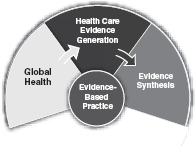The Synthesis of Evidence
 |
Evidence synthesis is a critical component of the JBI Model. The systematic review of the literature on a particular condition, intervention or issue is seen as core to defining reliable evidence for practice.
Synthesizing the best available international evidence related to a particular aspect of healthcare in a systematic way is complex and time consuming. It involves developing a clear, answerable question and locating all of the best available external evidence. Because this requires considerably more time and effort than most health professionals have at their disposal, independent, international evidence-based healthcare organizations made up of large numbers of appropriately trained reviewers are important to ensure that the evidence needs of healthcare professionals are not left unmet.
The complexities of synthesizing evidence generated in different ways are described in depth in volumes number 2–6 in the Lippincott-Joanna Briggs Institute Synthesis Science in Healthcare Series. The JBI Model assumes a common process to the synthesis of evidence following the systematic review approach developed by the Cochrane Collaboration (for reviews of effects and of diagnostic accuracy) and the Joanna Briggs Institute (for reviews of qualitative and economic evidence). The Cochrane Collaboration; the Campbell Collaboration (for reviews in education, criminal justice, and social welfare); and the Joanna Briggs Institute are the current independent, international sources of systematic reviews that are free of governmental and commercial influences; that transcend national boundaries; and that, to a large extent, attempt to follow similar approaches and adhere to similar standards in the conduct of systematic reviews. Traditionally the classical randomized controlled trial is seen as the highest form of evidence. The JBI Model of Evidence-Based Healthcare adopts a pluralistic approach to what constitutes evidence, where the “findings of qualitative research studies are regarded as rigorously generated evidence and other text derived from opinion, experience and expertise is acknowledged as forms of evidence” (Pearson, et al. 2005, p. 211) where ‘higher forms’ of evidence are unavailable or the question of interest is not one simply of effectiveness.
Systematic reviews are considered hierarchically as the highest form of evidence as they systematically search, identify, and summarize the available evidence that answers a focused
clinical question with particular attention to the methodological quality of studies (all papers are critically appraised) or the credibility of opinion and text.
clinical question with particular attention to the methodological quality of studies (all papers are critically appraised) or the credibility of opinion and text.
A common, internationally accepted approach to evidence synthesis/systematic reviews of evidence
The systematic review is a form of research; indeed, it is frequently referred to as ‘secondary research’. Primary research involves the design and conduct of a study, including the collection of primary data from patients and clients and its analysis and interpretation. The systematic review also collects and analyzes data – but usually from published and unpublished reports of completed research. Thus, the systematic reviewer uses secondary sources of data.
As in any research endeavor, the first step in the systematic review is the development of a proposal or protocol. Protocol development begins with an initial search of databases such as the Cochrane Database of Systematic Reviews; The Joanna Briggs Library of Systematic Reviews; and the Database of Abstracts of Reviews of Effects (DARE) to establish whether or not a recent review report exists. The Cochrane database can be accessed via http://www.cochrane.org; the JBI database can be accessed via http://connect.jbiconnectplus.org.easyaccess1.lib.cuhk.edu.hk/; the Campbell Collaboration can be accessed via http://www.campbellcollaboration.org/, and the DARE database can be found at http://www.york.ac.uk/inst/crd/darehp.htm.
If the topic has not been the subject of a systematic review, a review protocol is developed.
The Systematic Review Protocol
All of the three international, independent evidence review organizations adhere to a common structure for systematic review protocols. As in any research endeavor, the development of a rigorous research proposal or protocol is vital for a high quality systematic review. Systematic reviewers develop a protocol and subject it to peer review before commencing the review. For example, Cochrane Collaboration review protocols are approved by a relevant Cochrane Review Group before the review commences; JBI review protocols are approved by the JBI Synthesis Science Unit (SSU) before commencement; and the Campbell Collaboration requires registration of the protocol before the review is commenced. Once a protocol is finalized, it is lodged in an online database so that other reviewers interested in a given topic can search these databases to avoid duplication of reviews.
The review protocol provides a predetermined plan to ensure scientific rigor and minimize potential bias. It also allows for periodic updating of the review if necessary. Updating systematic reviews is imperative in a climate of continuous information production. New research knowledge is generated on a regular basis and therefore regular updates of systematic reviews are essential in order to ensure that health practices are based on the most current research evidence. It is generally accepted that this will occur on a three to five year cycle, or as deemed necessary (depending on the topic).
Stay updated, free articles. Join our Telegram channel

Full access? Get Clinical Tree


